Lead Poisoning

Lead poisoning is a type of metal poisoning caused by lead in the body. The brain is the most sensitive. Symptoms may include abdominal pain, constipation, headaches, irritability, memory problems, infertility, and tingling in the hands and feet. It causes almost 10% of intellectual disability of otherwise unknown cause and can result in behavioral problems. Some of the effects are permanent. In severe cases anemia, seizures, coma, or death may occur.
Exposure to lead can occur by contaminated air, water, dust, food, or consumer products. Children are at greater risk as they are more likely to put objects in their mouth such as those that contain lead paint and absorb a greater proportion of the lead that they eat. Exposure at work is a common cause of lead poisoning in adults with certain occupations at particular risk. Diagnosis is typically by measurement of the blood lead level. The Centers for Disease Control (US) has set the upper limit for blood lead for adults at 10 µg/dl (10 µg/100 g) and for children at 5 µg/dl. Elevated lead may also be detected by changes in red blood cells or dense lines in the bones of children as seen on X-ray.
Lead poisoning is preventable. This includes individual efforts such as removing lead-containing items from the home, workplace efforts such as improved ventilation and monitoring, state laws that ban the use of and national policies such as laws that ban lead in products such as paint, gasoline, ammunition, wheel weights, and fishing weights reduce allowable levels in water or soil, and provide for cleanup of contaminated soil. Workers’ education could be helpful as well. The major treatments are removal of the source of lead and the use of medications that bind lead so it can be eliminated from the body, known as chelation therapy. Chelation therapy in children is recommended when blood levels are greater than 40–45 µg/dl. Medications used include dimercaprol, edetate calcium disodium, and succimer.
In 2016, lead is believed to have resulted in 540,000 deaths worldwide. It occurs most commonly in the developing world. Those who are poor are at greater risk. Lead is believed to result in 0.6% of the world's disease burden. People have been mining and using lead for thousands of years. Descriptions of lead poisoning date to at least 2000 BC, while efforts to limit lead's use date back to at least the 16th century. Concerns for low levels of exposure begin in the 1970s with there being no safe threshold for lead exposure.
Classification
Classically, "lead poisoning" or "lead intoxication" has been defined as exposure to high levels of lead typically associated with severe health effects. Poisoning is a pattern of symptoms that occur with toxic effects from mid to high levels of exposure; toxicity is a wider spectrum of effects, including subclinical ones (those that do not cause symptoms). However, professionals often use "lead poisoning" and "lead toxicity" interchangeably, and official sources do not always restrict the use of "lead poisoning" to refer only to symptomatic effects of lead.
The amount of lead in the blood and tissues, as well as the time course of exposure, determine toxicity. Lead poisoning may be acute (from intense exposure of short duration) or chronic (from repeat low-level exposure over a prolonged period), but the latter is much more common. Diagnosis and treatment of lead exposure are based on blood lead level (the amount of lead in the blood), measured in micrograms of lead per deciliter of blood (μg/dL). Urine lead levels may be used as well, though less commonly. In cases of chronic exposure, lead often sequesters in the highest concentrations first in the bones, then in the kidneys. If a provider is performing a provocative excretion test, or "chelation challenge", a measurement obtained from urine rather than blood is likely to provide a more accurate representation of total lead burden to a skilled interpreter.
The US Centers for Disease Control and Prevention and the World Health Organization state that a blood lead level of 10 μg/dL or above is a cause for concern; however, lead may impair development and have harmful health effects even at lower levels, and there is no known safe exposure level. Authorities such as the American Academy of Pediatrics define lead poisoning as blood lead levels higher than 10 μg/dL.
Lead forms a variety of compounds and exists in the environment in various forms. Features of poisoning differ depending on whether the agent is an organic compound (one that contains carbon), or an inorganic one. Organic lead poisoning is now very rare, because countries across the world have phased out the use of organic lead compounds as gasoline additives, but such compounds are still used in industrial settings. Organic lead compounds, which cross the skin and respiratory tract easily, affect the central nervous system predominantly.
Signs and symptoms
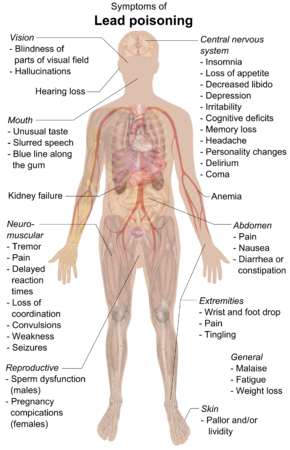
Lead poisoning can cause a variety of symptoms and signs which vary depending on the individual and the duration of lead exposure. Symptoms are nonspecific and may be subtle, and someone with elevated lead levels may have no symptoms. Symptoms usually develop over weeks to months as lead builds up in the body during a chronic exposure, but acute symptoms from brief, intense exposures also occur. Symptoms from exposure to organic lead, which is probably more toxic than inorganic lead due to its lipid solubility, occur rapidly. Poisoning by organic lead compounds has symptoms predominantly in the central nervous system, such as insomnia, delirium, cognitive deficits, tremor, hallucinations, and convulsions.
Symptoms may be different in adults and children; the main symptoms in adults are headache, abdominal pain, memory loss, kidney failure, male reproductive problems, and weakness, pain, or tingling in the extremities.
Early symptoms of lead poisoning in adults are commonly nonspecific and include depression, loss of appetite, intermittent abdominal pain, nausea, diarrhea, constipation, and muscle pain. Other early signs in adults include malaise, fatigue, decreased libido, and problems with sleep. An unusual taste in the mouth and personality changes are also early signs.
In adults, symptoms can occur at levels above 40 μg/dL, but are more likely to occur only above 50–60 μg/dL. Symptoms begin to appear in children generally at around 60 μg/dL. However, the lead levels at which symptoms appear vary widely depending on unknown characteristics of each individual. At blood lead levels between 25 and 60 μg/dL, neuropsychiatric effects such as delayed reaction times, irritability, and difficulty concentrating, as well as slowed motor nerve conduction and headache can occur. Anemia may appear at blood lead levels higher than 50 μg/dL. In adults, abdominal colic, involving paroxysms of pain, may appear at blood lead levels greater than 80 μg/dL. Signs that occur in adults at blood lead levels exceeding 100 μg/dL include wrist drop and foot drop, and signs of encephalopathy (a condition characterized by brain swelling), such as those that accompany increased pressure within the skull, delirium, coma, seizures, and headache. In children, signs of encephalopathy such as bizarre behavior, discoordination, and apathy occur at lead levels exceeding 70 μg/dL. For both adults and children, it is rare to be asymptomatic if blood lead levels exceed 100 μg/dL.
Acute poisoning
In acute poisoning, typical neurological signs are pain, muscle weakness, numbness and tingling, and, rarely, symptoms associated with inflammation of the brain. Abdominal pain, nausea, vomiting, diarrhea, and constipation are other acute symptoms. Lead's effects on the mouth include astringency and a metallic taste. Gastrointestinal problems, such as constipation, diarrhea, poor appetite, or weight loss, are common in acute poisoning. Absorption of large amounts of lead over a short time can cause shock (insufficient fluid in the circulatory system) due to loss of water from the gastrointestinal tract. Hemolysis (the rupture of red blood cells) due to acute poisoning can cause anemia and hemoglobin in the urine. Damage to kidneys can cause changes in urination such as decreased urine output. People who survive acute poisoning often go on to display symptoms of chronic poisoning.
Chronic poisoning
Chronic poisoning usually presents with symptoms affecting multiple systems, but is associated with three main types of symptoms: gastrointestinal, neuromuscular, and neurological. Central nervous system and neuromuscular symptoms usually result from intense exposure, while gastrointestinal symptoms usually result from exposure over longer periods. Signs of chronic exposure include loss of short-term memory or concentration, depression, nausea, abdominal pain, loss of coordination, and numbness and tingling in the extremities. Fatigue, problems with sleep, headaches, stupor, slurred speech, and anemia are also found in chronic lead poisoning. A "lead hue" of the skin with pallor and/or lividity is another feature. A blue line along the gum with bluish black edging to the teeth, known as a Burton line, is another indication of chronic lead poisoning. Children with chronic poisoning may refuse to play or may have hyperkinetic or aggressive behavior disorders. Visual disturbance may present with gradually progressing blurred vision as a result of central scotoma, caused by toxic optic neuritis.
Effects on children
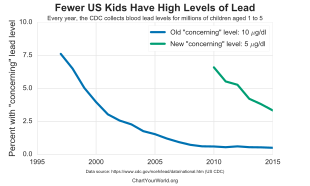
A pregnant woman who has elevated blood lead levels is at greater risk of a premature birth or with a low birth weight. Children are more at risk for lead poisoning because their smaller bodies are in a continuous state of growth and development. Young children are much more vulnerable to lead poisoning, as they absorb 4 to 5 times more lead than an adult from a given source. Furthermore, children, especially as they are learning to crawl and walk, are constantly on the floor and therefore more prone to ingesting and inhaling dust that is contaminated with lead.
The classic signs and symptoms in children are loss of appetite, abdominal pain, vomiting, weight loss, constipation, anemia, kidney failure, irritability, lethargy, learning disabilities, and behavioral problems. Slow development of normal childhood behaviors, such as talking and use of words, and permanent intellectual disability are both commonly seen. Although less common, it is possible for fingernails to develop leukonychia striata if exposed to abnormally high lead concentrations.
On July 30, 2020, a report by UNICEF and Pure Earth revealed that lead poisoning is affecting children on a “massive and previously unknown scale.” According to the report, one in three children, up to 800 million globally, have blood lead levels at, or above, 5 micrograms per decilitre (µg/dL), the amount at which action is required.
By organ system
Lead affects every one of the body's organ systems, especially the nervous system, but also the bones and teeth, the kidneys, and the cardiovascular, immune, and reproductive systems. Hearing loss and tooth decay have been linked to lead exposure, as have cataracts. Intrauterine and neonatal lead exposure promote tooth decay. Aside from the developmental effects unique to young children, the health effects experienced by adults are similar to those in children, although the thresholds are generally higher.
Kidneys
Kidney damage occurs with exposure to high levels of lead, and evidence suggests that lower levels can damage kidneys as well. The toxic effect of lead causes nephropathy and may cause Fanconi syndrome, in which the proximal tubular function of the kidney is impaired. Long-term exposure at levels lower than those that cause lead nephropathy have also been reported as nephrotoxic in patients from developed countries that had chronic kidney disease or were at risk because of hypertension or diabetes mellitus. Lead poisoning inhibits excretion of the waste product urate and causes a predisposition for gout, in which urate builds up. This condition is known as saturnine gout.
Cardiovascular system
Evidence suggests lead exposure is associated with high blood pressure, and studies have also found connections between lead exposure and coronary heart disease, heart rate variability, and death from stroke, but this evidence is more limited. People who have been exposed to higher concentrations of lead may be at a higher risk for cardiac autonomic dysfunction on days when ozone and fine particles are higher.
Reproductive system
Lead affects both the male and female reproductive systems. In men, when blood lead levels exceed 40 μg/dL, sperm count is reduced and changes occur in volume of sperm, their motility, and their morphology. A pregnant woman's elevated blood lead level can lead to miscarriage, prematurity, low birth weight, and problems with development during childhood. Lead is able to pass through the placenta and into breast milk, and blood lead levels in mothers and infants are usually similar. A fetus may be poisoned in utero if lead from the mother's bones is subsequently mobilized by the changes in metabolism due to pregnancy; increased calcium intake in pregnancy may help mitigate this phenomenon.
Nervous system

Lead affects the peripheral nervous system (especially motor nerves) and the central nervous system. Peripheral nervous system effects are more prominent in adults and central nervous system effects are more prominent in children. Lead causes the axons of nerve cells to degenerate and lose their myelin coats.
Lead exposure in young children has been linked to learning disabilities, and children with blood lead concentrations greater than 10 μg/dL are in danger of developmental disabilities. Increased blood lead level in children has been correlated with decreases in intelligence, nonverbal reasoning, short-term memory, attention, reading and arithmetic ability, fine motor skills, emotional regulation, and social engagement.
The effect of lead on children's cognitive abilities takes place at very low levels. There is apparently no lower threshold to the dose-response relationship (unlike other heavy metals such as mercury). Reduced academic performance has been associated with lead exposure even at blood lead levels lower than 5 μg/dL. Blood lead levels below 10 μg/dL have been reported to be associated with lower IQ and behavior problems such as aggression, in proportion with blood lead levels. Between the blood lead levels of 5 and 35 μg/dL, an IQ decrease of 2–4 points for each μg/dL increase is reported in children. However, studies that show associations between low-level lead exposure and health effects in children may be affected by confounding and overestimate the effects of low-level lead exposure.
High blood lead levels in adults are also associated with decreases in cognitive performance and with psychiatric symptoms such as depression and anxiety. It was found in a large group of current and former inorganic lead workers in Korea that blood lead levels in the range of 20–50 μg/dL were correlated with neuro-cognitive defects. Increases in blood lead levels from about 50 to about 100 μg/dL in adults have been found to be associated with persistent, and possibly permanent, impairment of central nervous system function.
Lead exposure in children is also correlated with neuropsychiatric disorders such as attention deficit hyperactivity disorder and anti-social behaviour. Elevated lead levels in children are correlated with higher scores on aggression and delinquency measures. A correlation has also been found between prenatal and early childhood lead exposure and violent crime in adulthood. Countries with the highest air lead levels have also been found to have the highest murder rates, after adjusting for confounding factors. A May 2000 study by economic consultant Rick Nevin theorizes that lead exposure explains 65% to 90% of the variation in violent crime rates in the US. A 2007 paper by the same author claims to show a strong association between preschool blood lead and subsequent crime rate trends over several decades across nine countries. Lead exposure in childhood appears to increase school suspensions and juvenile detention among boys. It is believed that the U.S. ban on lead paint in buildings in the late 1970s, as well as the phaseout of leaded gasoline in the 1970s and 1980s, partially helped contribute to the decline of violent crime in the United States since the early 1990s.
Exposure routes
Lead is a common environmental pollutant. Causes of environmental contamination include industrial use of lead, such as found in facilities that process lead-acid batteries or produce lead wire or pipes, and metal recycling and foundries. Storage batteries and ammunition are made with the largest amounts of lead consumed in the economy each year, in the US as of 2013. Children living near facilities that process lead, such as lead smelters, have been found to have unusually high blood lead levels. In August 2009, parents rioted in China after lead poisoning was found in nearly 2000 children living near zinc and manganese smelters. Lead exposure can occur from contact with lead in air, household dust, soil, water, and commercial products. Leaded gasoline has also been linked to increases in lead pollution. Some research has suggested a link between leaded gasoline and crime rates. Man made lead pollution has been elevated in the air for the past 2000 years. Lead pollution in the air is entirely due to human activity (mining and smelting).
Occupational exposure

In adults, occupational exposure is the main cause of lead poisoning. People can be exposed when working in facilities that produce a variety of lead-containing products; these include radiation shields, ammunition, certain surgical equipment, developing dental x-ray films prior to digital x-rays (each film packet had a lead liner to prevent the radiation from going through), fetal monitors, plumbing, circuit boards, jet engines, and ceramic glazes. In addition, lead miners and smelters, plumbers and fitters, auto mechanics, glass manufacturers, construction workers, battery manufacturers and recyclers, firing range workers, and plastic manufacturers are at risk for lead exposure. Other occupations that present lead exposure risks include welding, manufacture of rubber, printing, zinc and copper smelting, processing of ore, combustion of solid waste, and production of paints and pigments. Lead exposure can also occur with intense use of gun ranges, regardless of whether these ranges are indoor or out. Parents who are exposed to lead in the workplace can bring lead dust home on clothes or skin and expose their children. Occupational exposure to lead increases the risk of cardiovascular disease, in particular: stroke, and high blood pressure.
Food
Lead may be found in food when food is grown in soil that is high in lead, airborne lead contaminates the crops, animals eat lead in their diet, or lead enters the food either from what it was stored or cooked in.
In Bangladesh, lead compounds have been added to turmeric to make it more yellow. This is believed to have started in the 1980s and continues as of 2019. It is believed to be one of the main sources of high lead levels in the country. In Hong Kong the maximum allowed lead parts per million is 6 in solid foods and 1 in liquid foods.
Paint
Some lead compounds are colorful and are used widely in paints, and lead paint is a major route of lead exposure in children. A study conducted in 1998–2000 found that 38 million housing units in the US had lead-based paint, down from a 1990 estimate of 64 million. Deteriorating lead paint can produce dangerous lead levels in household dust and soil. Deteriorating lead paint and lead-containing household dust are the main causes of chronic lead poisoning. The lead breaks down into the dust and since children are more prone to crawling on the floor, it is easily ingested. Many young children display pica, eating things that are not food. Even a small amount of a lead-containing product such as a paint chip or a sip of glaze can contain tens or hundreds of milligrams of lead. Eating chips of lead paint presents a particular hazard to children, generally producing more severe poisoning than occurs from dust. Because removing lead paint from dwellings, e.g. by sanding or torching, creates lead-containing dust and fumes, it is generally safer to seal the lead paint under new paint (excepting moveable windows and doors, which create paint dust when operated). Alternatively, special precautions must be taken if the lead paint is to be removed. In oil painting it was once common for colours such as yellow or white to be made with lead carbonate. Lead white oil colour was the main white of oil painters until superseded by compounds containing zinc or titanium in the mid-20th century. It is speculated that the painter Caravaggio and possibly Francisco Goya and Vincent Van Gogh had lead poisoning due to overexposure or carelessness when handling this colour.
Soil

Residual lead in soil contributes to lead exposure in urban areas. It has been thought that the more polluted an area is with various contaminants, the more likely it is to contain lead. However, this is not always the case, as there are several other reasons for lead contamination in soil. Lead content in soil may be caused by broken-down lead paint, residues from lead-containing gasoline, used engine oil, tire weights, or pesticides used in the past, contaminated landfills, or from nearby industries such as foundries or smelters. Although leaded soil is less of a problem in countries that no longer have leaded gasoline, it remains prevalent, raising concerns about the safety of urban agriculture; eating food grown in contaminated soil can present a lead hazard.

Water
Lead from the atmosphere or soil can end up in groundwater and surface water. It is also potentially in drinking water, e.g. from plumbing and fixtures that are either made of lead or have lead solder. Since acidic water breaks down lead in plumbing more readily, chemicals can be added to municipal water to increase the pH and thus reduce the corrosivity of the public water supply. Chloramines, which were adopted as a substitute for chlorine disinfectants due to fewer health concerns, increase corrositivity. In the US, 14–20% of total lead exposure is attributed to drinking water. In 2004, a team of seven reporters from The Washington Post discovered high levels of lead in the drinking water in Washington DC and won an award for investigative reporting for a series of articles about this contamination. In the Flint water crisis (Flint, Michigan), a switch to a more corrosive municipal water source caused elevated lead levels in domestic tap water.
Like Flint MI and Washington DC, a similar situation affects the State of Wisconsin, where estimates call for replacement of up to 176,000 underground pipes made of lead known as lead service lines. The city of Madison, Wisconsin addressed the issue and replaced all of their lead service lines, but there are still others that have yet to follow suit. While there are chemical methods that could help reduce the amount of lead in the water distributed, a permanent fix would be to replace the pipes completely. While the state may replace the pipes below ground, it will be up to the homeowners to replace the pipes on their property, at an average cost of $3,000. Experts say that if the city were to replace their pipes and the citizens were to keep the old pipes located within their homes, there would be a potential for more lead to dissolve into their drinking water.
Collected rainwater from roof runoff used as potable water may contain lead, if there are lead contaminants on the roof or in the storage tank. The Australian Drinking Water Guidelines allow a maximum of 0.01 mg/L (10 ppb) lead in water.
Lead wheel weights have been found to accumulate on roads and interstates and erode in traffic entering the water runoff through drains. Leaded fishing weights accumulate in rivers, streams, ponds, and lakes.
Lead-containing products
Lead can be found in products such as kohl, an ancient cosmetic from the Middle East, South Asia, and parts of Africa that has many other names; and from some toys. In 2007, millions of toys made in China were recalled from multiple countries owing to safety hazards including lead paint. Vinyl mini-blinds, found especially in older housing, may contain lead. Lead is commonly incorporated into herbal remedies such as Indian Ayurvedic preparations and remedies of Chinese origin. There are also risks of elevated blood lead levels caused by folk remedies like azarcon and greta, which each contain about 95% lead.
Ingestion of metallic lead, such as small lead fishing lures, increases blood lead levels and can be fatal. Ingestion of lead-contaminated food is also a threat. Ceramic glaze often contains lead, and dishes that have been improperly fired can leach the metal into food, potentially causing severe poisoning. In some places, the solder in cans used for food contains lead. When manufacturing medical instruments and hardware, solder containing lead may be present. People who eat animals hunted with lead bullets may be at risk for lead exposure. Bullets lodged in the body rarely cause significant levels of lead, but bullets lodged in the joints are the exception, as they deteriorate and release lead into the body over time.
In May 2015, Indian food safety regulators in the state of Uttar Pradesh found that samples of Maggi 2 Minute Noodles contained lead up to 17 times beyond permissible limits. On 3 June 2015, New Delhi Government banned the sale of Maggi noodles in New Delhi stores for 15 days because it was found to contain lead beyond the permissible limit. The Gujarat FDA on June 4, 2015 banned the noodles for 30 days after 27 out of 39 samples were detected with objectionable levels of metallic lead, among other things. Some of India's biggest retailers like Future Group, Big Bazaar, Easyday and Nilgiris have imposed a nationwide ban on Maggi noodles. Many other states too have banned Maggi noodles.
Bullets
Contact with ammunition is a source of lead exposure. As of 2013, lead-based ammunition production is the second largest annual use of lead in the US, accounting for over 84,800 metric tons consumed in 2013, second only to the manufacture of storage batteries. The Environmental Protection Agency (EPA) cannot regulate cartridges and shells, as a matter of law. Lead birdshot is banned in some areas, but this is primarily for the benefit of the birds and their predators, rather than humans. Contamination from heavily used gun ranges are of concern to those who live near by. Non-lead alternatives include steel, tungsten-nickel-iron, bismuth-tin, and tungsten-polymer.
Because game animals can be shot using lead bullets, the potential for lead ingestion from game meat consumption has been studied clinically and epidemiologically. In a recent study conducted by the CDC, a cohort from North Dakota was enrolled and asked to self-report historical consumption of game meat, and participation in other activities that could cause lead exposure. The study found that participants' age, sex, housing age, current hobbies with potential for lead exposure, and game consumption were all associated with blood lead level (PbB).
According to a study published in 2008, 1.1% of the 736 persons consuming wild game meat tested had PbB ≥5 μg/dl In November 2015 The US HHS/CDC/NIOSH designated 5 µg/dL (five micrograms per deciliter) of whole blood, in a venous blood sample, as the reference blood lead level for adults. An elevated BLL is defined as a BLL ≥5 µg/dL. This case definition is used by the ABLES program, the Council of State and Territorial Epidemiologists (CSTE), and CDC's National Notifiable Diseases Surveillance System (NNDSS). Previously (i.e. from 2009 until November 2015), the case definition for an elevated BLL was a BLL ≥10 µg/dL.
Copper-jacketed, lead-based bullets are more economical to produce and use than lead or any other material. Alternative materials are available such as steel, copper, and tungsten, but alternatives are universally less effective and/or more expensive. However, the biggest impediment to using the vast majority of alternatives relates to current laws in the United States pertaining to armor-piercing rounds. Laws and regulations relating to armor-piercing ammunition expressly prohibit the use of brass, bronze, steel, tungsten, and nearly every metallic alternative in any bullet that can be shot by a handgun, which at this time is nearly every caliber smaller than 50BMG (including the popular .223 Remington, .308 Winchester and .30-06 to name just a few). Some lead-based bullets are resistant to fragmentation, offering hunters the ability to clean game animals with negligible risk of including lead fragments in prepared meat. Other bullets are prone to fragmentation and exacerbate the risk of lead ingestion from prepared meat. In practice, use of a non-fragmenting bullet and proper cleaning of the game animal's wound can eliminate the risk of lead ingestion from eating game; however, isolating such practice to experimentally determine its association with blood lead levels in study is difficult. Bismuth is an element used as a lead-replacement for shotgun pellets used in waterfowl hunting although shotshells made from bismuth are nearly ten times the cost of lead.
Opium
Lead contaminated opium has been the source of poisoning in Iran and other Middle Eastern countries. This has also appeared in the illicit narcotic supply in North America, resulting in confirmed lead poisoning.
Pathophysiology

Exposure occurs through inhalation, ingestion or occasionally skin contact. Lead may be taken in through direct contact with mouth, nose, and eyes (mucous membranes), and through breaks in the skin. Tetraethyllead, which was a gasoline additive and is still used in avgas, passes through the skin; however inorganic lead found in paint, food, and most lead-containing consumer products is only minimally absorbed through the skin. The main sources of absorption of inorganic lead are from ingestion and inhalation. In adults, about 35–40% of inhaled lead dust is deposited in the lungs, and about 95% of that goes into the bloodstream. Of ingested inorganic lead, about 15% is absorbed, but this percentage is higher in children, pregnant women, and people with deficiencies of calcium, zinc, or iron. Infants may absorb about 50% of ingested lead, but little is known about absorption rates in children.
The main body tissues that store lead are the blood, soft tissues, and bone; the half-life of lead in these tissues is measured in weeks for blood, months for soft tissues, and years for bone. Lead in the bones, teeth, hair, and nails is bound tightly and not available to other tissues, and is generally thought not to be harmful. In adults, 94% of absorbed lead is deposited in the bones and teeth, but children only store 70% in this manner, a fact which may partially account for the more serious health effects on children. The estimated half-life of lead in bone is 20 to 30 years, and bone can introduce lead into the bloodstream long after the initial exposure is gone. The half-life of lead in the blood in men is about 40 days, but it may be longer in children and pregnant women, whose bones are undergoing remodeling, which allows the lead to be continuously re-introduced into the bloodstream. Also, if lead exposure takes place over years, clearance is much slower, partly due to the re-release of lead from bone. Many other tissues store lead, but those with the highest concentrations (other than blood, bone, and teeth) are the brain, spleen, kidneys, liver, and lungs. Lead is removed from the body very slowly, mainly through urine. Smaller amounts of lead are also eliminated through the feces, and very small amounts in hair, nails, and sweat.
Lead has no known physiologically relevant role in the body, and its harmful effects are myriad. Lead and other heavy metals create reactive radicals which damage cell structures including DNA and cell membranes. Lead also interferes with DNA transcription, enzymes that help in the synthesis of vitamin D, and enzymes that maintain the integrity of the cell membrane. Anemia may result when the cell membranes of red blood cells become more fragile as the result of damage to their membranes. Lead interferes with metabolism of bones and teeth and alters the permeability of blood vessels and collagen synthesis. Lead may also be harmful to the developing immune system, causing production of excessive inflammatory proteins; this mechanism may mean that lead exposure is a risk factor for asthma in children. Lead exposure has also been associated with a decrease in activity of immune cells such as polymorphonuclear leukocytes. Lead also interferes with the normal metabolism of calcium in cells and causes it to build up within them.
Enzymes
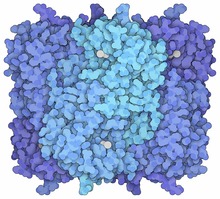
The primary cause of lead's toxicity is its interference with a variety of enzymes because it binds to sulfhydryl groups found on many enzymes. Part of lead's toxicity results from its ability to mimic other metals that take part in biological processes, which act as cofactors in many enzymatic reactions, displacing them at the enzymes on which they act. Lead is able to bind to and interact with many of the same enzymes as these metals but, due to its differing chemistry, does not properly function as a cofactor, thus interfering with the enzyme's ability to catalyze its normal reaction or reactions. Among the essential metals with which lead interacts are calcium, iron, and zinc.
The lead ion has a lone pair in its electronic structure, which can result in a distortion in the coordination of ligands, and in 2007 was hypothesized to be important in lead poisoning's effects on enzymes (see Lone pair § Unusual lone pairs).
One of the main causes for the pathology of lead is that it interferes with the activity of an essential enzyme called delta-aminolevulinic acid dehydratase, or ALAD (see image of the enzyme structure), which is important in the biosynthesis of heme, the cofactor found in hemoglobin. Lead also inhibits the enzyme ferrochelatase, another enzyme involved in the formation of heme. Ferrochelatase catalyzes the joining of protoporphyrin and Fe2+ to form heme. Lead's interference with heme synthesis results in production of zinc protoporphyrin and the development of anemia. Another effect of lead's interference with heme synthesis is the buildup of heme precursors, such as aminolevulinic acid, which may be directly or indirectly harmful to neurons. Elevation of aminolevulinic acid results in lead poisoning having symptoms similar to porphyria.
Neurons
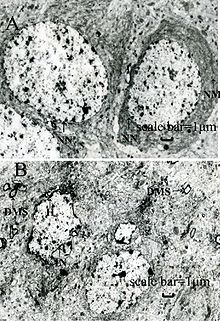
The brain is the organ most sensitive to lead exposure. Lead is able to pass through the endothelial cells at the blood brain barrier because it can substitute for calcium ions and be uptaken by calcium-ATPase pumps. Lead poisoning interferes with the normal development of a child's brain and nervous system; therefore children are at greater risk of lead neurotoxicity than adults are. In a child's developing brain, lead interferes with synapse formation in the cerebral cortex, neurochemical development (including that of neurotransmitters), and organization of ion channels. It causes loss of neurons' myelin sheaths, reduces numbers of neurons, interferes with neurotransmission, and decreases neuronal growth.
Lead-ions (Pb2+), like magnesium-ions (Mg2+), block NMDA receptors. Therefore, an increase in Pb2+ concentration will effectively inhibit ongoing long-term potentiation (LTP), and lead to an abnormal increase in long-term depression (LTD) on neurons in the affected parts of the nervous system. These abnormalities lead to the indirect downregulation of NMDA-receptors, effectively initiating a positive feedback-loop for LTD. The targeting of NMDA receptors is thought to be one of the main causes for lead's toxicity to neurons.
Diagnosis
Diagnosis includes determining the clinical signs and the medical history, with inquiry into possible routes of exposure. Clinical toxicologists, medical specialists in the area of poisoning, may be involved in diagnosis and treatment. The main tool in diagnosing and assessing the severity of lead poisoning is laboratory analysis of the blood lead level (BLL).
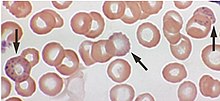
Blood film examination may reveal basophilic stippling of red blood cells (dots in red blood cells visible through a microscope), as well as the changes normally associated with iron-deficiency anemia (microcytosis and hypochromasia). This may be known as sideroblastic anemia. However, basophilic stippling is also seen in unrelated conditions, such as megaloblastic anemia caused by vitamin B12 (colbalamin) and folate deficiencies. Contrary to other sideroblastic anemia, there are no ring sideroblasts in a bone marrow smear.
Exposure to lead also can be evaluated by measuring erythrocyte protoporphyrin (EP) in blood samples. EP is a part of red blood cells known to increase when the amount of lead in the blood is high, with a delay of a few weeks. Thus EP levels in conjunction with blood lead levels can suggest the time period of exposure; if blood lead levels are high but EP is still normal, this finding suggests exposure was recent. However, the EP level alone is not sensitive enough to identify elevated blood lead levels below about 35 μg/dL. Due to this higher threshold for detection and the fact that EP levels also increase in iron deficiency, use of this method for detecting lead exposure has decreased.
Blood lead levels are an indicator mainly of recent or current lead exposure, not of total body burden. Lead in bones can be measured noninvasively by X-ray fluorescence; this may be the best measure of cumulative exposure and total body burden. However this method is not widely available and is mainly used for research rather than routine diagnosis. Another radiographic sign of elevated lead levels is the presence of radiodense lines called lead lines at the metaphysis in the long bones of growing children, especially around the knees. These lead lines, caused by increased calcification due to disrupted metabolism in the growing bones, become wider as the duration of lead exposure increases. X-rays may also reveal lead-containing foreign materials such as paint chips in the gastrointestinal tract.
Fecal lead content that is measured over the course of a few days may also be an accurate way to estimate the overall amount of childhood lead intake. This form of measurement may serve as a useful way to see the extent of oral lead exposure from all the diet and environmental sources of lead.
Lead poisoning shares symptoms with other conditions and may be easily missed. Conditions that present similarly and must be ruled out in diagnosing lead poisoning include carpal tunnel syndrome, Guillain–Barré syndrome, renal colic, appendicitis, encephalitis in adults, and viral gastroenteritis in children. Other differential diagnoses in children include constipation, abdominal colic, iron deficiency, subdural hematoma, neoplasms of the central nervous system, emotional and behavior disorders, and intellectual disability.